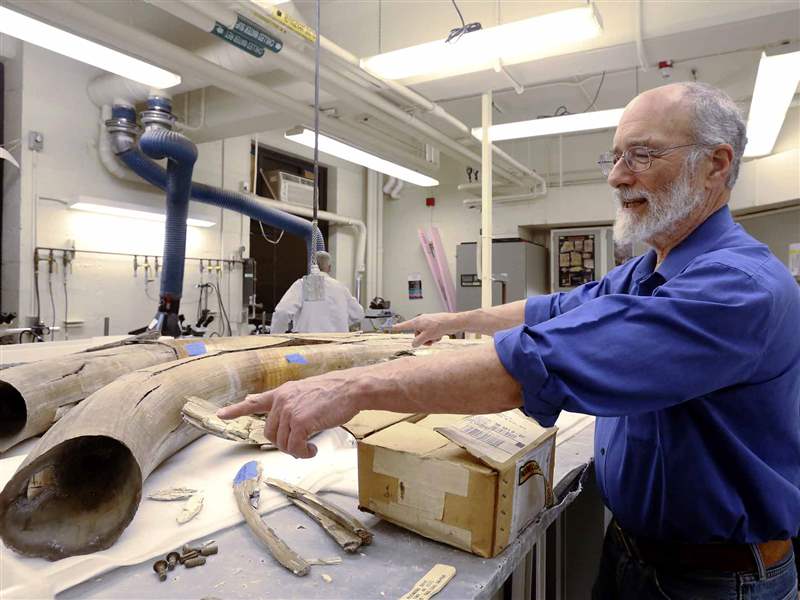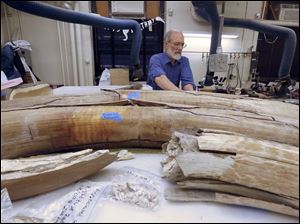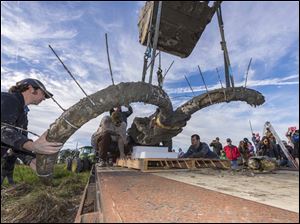
Bristle Mammoth uncovered under Michigan farm
1/20/2018
University of Michigan paleontologist Daniel Fisher sits near Bristle Mammoth tusks that were excavated from the Bristle farm.
The Blade/Amy E. Voigt
Buy This Image
ANN ARBOR — He was a mighty beast, a full-grown ice age mammoth in his 40s who stood nearly 13 feet tall, took up 22 feet of land at any given time, and weighed a whopping 6 tons.
And he likely put up one helluva fight when another male bested him in a winner-take-all battle for a female about 15,000 years ago on land west of what is now Ann Arbor. It was a confrontation in nature that certainly has not been limited to prehistoric times.
But what really excites University of Michigan paleontologist Daniel Fisher about the 2015 discovery of the Bristle Mammoth — named after the Chelsea-area family from whose farm it was extracted — is the evidence that has emerged from a close-up examination of the bones: It appears the animal was found by humans, butchered, and submerged into a pond to preserve much of its valuable meat for those times when food was scarce.

University of Michigan paleontologist Daniel Fisher sits near Bristle Mammoth tusks that were excavated from the Bristle farm.
That, according to Mr. Fisher, is the strongest evidence to date that humans existed in Michigan at least 15,000 years ago. It is widely documented that humans have existed in Michigan for 13,000 years, meaning the discovery of this mammoth could push that date back another two millennia.
“It lived more than 15,000 years ago, and we have evidence humans were processing this animal,” Mr. Fisher said.
Anecdotal? Perhaps. Mr. Fisher is one of 11 scientists who co-wrote a 2016 paper that said there now appears to be evidence humans were in North America, near what is now San Diego, as many as 130,000 years ago.
But even that paper, published in the scientific journal Nature last April 26 (go.nature.com/2ATSNYQ) concedes in the first sentence of its abstract that the general topic of human origins remains “a contentious subject.” And, of course, it can’t be assumed humans were spread evenly across North America.
The belief that human life might have existed in North America 130,000 years ago is a result of archaeological evidence, radiometric dating, and artifacts. It is based on fragmentary remains of a single mastodon found in 1992 in what is now southern California. An examination of those bones over many years revealed evidence that “humans with manual dexterity and the experiential knowledge to use hammerstones and anvils processed mastodon limb bones for marrow extraction and/or raw material for tool production,” according to the scientific paper.
Jon Erlandson, a University of Oregon archaeologist who specializes in the research of human origins, told a national magazine the “claims made are extraordinary and the potential implications staggering,” adding it will take more than a mastodon’s broken bones to convince him humans were in North America that far back in history.
Using the Bristle Mammoth to place humans in Michigan 15,000 years ago, though, is much less contentious.
Scientists generally agree humans have been in other parts of North America for at least 14,000 years and that they likely migrated to the continent from what is now Africa, Europe, or Asia.
Strengthening the evidence for Michigan — and possibly even pushing that human habitation date back by another 2,000 years — is the most important development of the Bristle Mammoth discovery, Mr. Fisher said.
The Bristle Mammoth is one of about 30 mammoth skeletons found across Michigan over the years, and one of the most complete.

University of Michigan Museum of Paleontology collections manager Adam Rountrey (left), Earth and Environmental Sciences undergraduate David Vander Weele (center) and paleontology Ph. D. candidate Michael Cherney (right) help guide the Mammoth skull and tusks as they are lowered onto a flatbed trailer.
“Most [sites yield] isolated teeth or a handful of bones. At only four to five have significant parts been found,” Mr. Fisher said.
The discovery was made on a farm near Chelsea owned by James Bristle, who at the time was installing a drainage system at a low spot in one of his fields.
“The only way to drain it was to put in a sump pump,” Mr. Bristle said.
While digging in one area, the farmer and his neighbor, Trent Satterwaite, came across what looked like pieces of old bones while trying to install 10-inch drainage tile on land Mr. Bristle had just purchased months earlier.
“When we brought up a hip bone, we knew it was not something normal,” Mr. Bristle said.
They contacted UM. Mr. Fisher just happened to be in town and made a trip out to the site immediately. Once there, he confirmed what they had found, and made arrangements for the first excavation.
“I didn’t want them to be digging here months on end,” Mr. Bristle said. “I just wanted to tile my field.”
Word got out, though, and the Bristle farm became an instant attraction. Mothers and grandmothers pulled their kids out of school, knowing it was a once-in-a-lifetime opportunity for them to see prehistoric bones unearthed. About 300 people made impromptu visits, with as many as 30 cars in the family’s driveway at one time.
The Bristles took it in stride, at first feeling a little overwhelmed but realizing it was all for a good cause. They even renamed their farm Mammoth Acres.
“I think it makes us all wonder what’s under all of us. This was just a chance find,” Mr. Bristle said. “I’ve learned a little bit about history myself.”
He said he was pleased by the way Mr. Fisher and other UM researchers handled the situation.
“Dan Fisher’s been super,” Mr. Bristle said. “He’s been a top-notch guy to work with.”
The pond where the carcass was stored no longer exists. The skeleton was found 10 feet below the farm’s surface.
The farmer has since opened his land to UM researchers on two occasions: On Oct. 1, 2015, when 55 to 60 nearly complete mammoth bones were excavated, and last Nov. 29, when a second trip to the site resulted in an additional 40 bones being recovered.
A UM video produced at the site of the first dig has been viewed almost a million times.
VIDEO: Mammoth excavation
Mammoths, which are close relatives of modern Asian elephants, often lived into their 60s. Native to Africa, they’re believed to have first existed on Earth some 7.5 million years ago. They migrated to Asia, Eurasia, and other parts of the world, coming to North America from Siberia some 1.6 million years ago after the beginning of the Ice Age, according to UM.
Mastodons lived during the same period, but are noted for having straighter tusks, lower shoulders. shorter legs and flatter heads. They are a different species of the Proboscidean family.
University researchers have thus far recovered about 275 mammoth bones from the Bilster farm, meaning a little more than a third — but no more than 40 percent — of the skeleton. That still makes it one of the more complete sets, Mr. Fisher said.
“More than 20 or 30 percent of any animal is pretty good,” he said.
But the number of bones and the percentage of any skeleton is secondary to the historical evidence that’s generated, according to Mr. Fisher, who also is UM’s Museum of Paleontology director.
This particular mammoth’s skull was still nearly intact, though crushed in one part of its left forehead by what might have been the fatal blow from its battle to the death with the other male. Large portions of the tusks were intact, but not enough to be part of the skull’s permanent display. A cast was made, based on what scientists pieced together from the broken parts of the tusk.
The most notably missing parts were the animals legs and feet.
No additional digging is planned, according to Mr. Fisher, who also said researchers never found evidence of the other male or the female the two were believed to be fighting over. By examining the color of growth layers in the tusks — akin to growth layers in trees — scientists were able to determine the fight occurred in the early summer.
That further supports the belief that it was a fight between two dominant males for a female, because early summer was mating season for mammoths, Mr. Fisher said.
“Look at this,” he said inside his lab, exuding almost boyish glee as he held together two recovered vertebrae that are perfectly aligned. “They’re articulated.”
Finding a prehistoric spine that well intact is a paleontologist’s dream, Mr. Fisher explained.
This particular mammoth was a hybrid between a woolly mammoth, a beast adapted to Siberia and other frigid climates, and a Columbian mammoth, which preferred Central America and other areas with warmer climates. About half of the 30 mammoths found in Michigan were hybrids of some kind.
So what’s more common, a mammoth or a mastodon?
Mastodons by far. Nationally, there have been 10 times as many mastodons found as mammoths. About 300 mastodons have been found in Michigan, Mr. Fisher said.
Mr. Bristle donated the mammoth remains to UM. Bones are still being cleaned and identified, Mr. Fisher said.
The university put most of the biggest ones on display inside its Museum of Natural History in November, 2016.
They remained on display until Dec. 31, when the museum was closed to the public in preparation for relocation to another building on campus.
The museum is expected to reopen in 2019 after that move has been completed, at which point most of the recovered Bristle Mammoth remains will go back on display.
Contact Tom Henry at thenry@theblade.com, 419-724-6079, or via Twitter @ecowriterohio.